Hickey Farms is a large-scale tillage and beef farming enterprise, run by Gerard Hickey alongside his father Martin and uncle Patrick, on the outskirts of Ardee. The farm currently comprises 2,000 acres of cereals, 600 acres of potatoes and 250 acres of vegetables alongside 400 head of beef cattle.
In order to get through the heavy workload, the Hickeys run two Rauch Axis 30.2 EMC mounted fertiliser spreaders. Spreading large quantities of product and covering big acreage annually and after numerous new machines, the family has stuck with the Rauch brand since 2004.
Why mounted?
While the Hickeys could more than justify a large capacity trailed spreader, Gerard and the lads feel that two mounted machines suit their situation best. “With the mounted spreaders we can either run both together or split them up. Two machines work well together when applying straights. For example, one machine could be setup for nitrogen and the other for potash which means we can finish one block and move onto the next without having to continuously make setting changes. In the earlier years too, we found the accuracy of mounted spreaders much better,” outlined Gerard.
Another benefit Gerard pointed out about running mounted machines over trailed was replacement cost and the ability to stagger their replacement.

Working on 30m tramlines, the spreaders are fitted with S8 discs.

The Hickey's fabricate and fit a stainless steel access platform to help when loading the spreader.
Axis-M 30.2 EMC
In recent months, the Hickeys have upgraded their spreaders for two new identical Axis M 30.2 EMC machines, the same as the previous models.
Although Rauch do offer a higher capacity mounted Axis M 50.2 EMC+W model with a 4,200l capacity hopper, Gerard feels that it is too much weight and requires too large of a tractor. The 3,200l hopper of the Axis M 30.2 EMC on the other hand is a better all-rounder.
“There are times a tonne or two less could be the difference in working and not working,” he said.
“We tend to fill on the headland with a telehandler so it’s not a big loss in time if we carry a tonne less and refill more frequently. Anything larger is placing a lot of weight on the tractor’s back axle which in turn means additional ballast and a heavier overall gross weight which isn’t good on the shoulders of the year
when the aim is to minimise soil compaction.”
The Hickeys run 30m tramlines so therefore opt to run S8 (30-42m) discs and vanes. Although S6 (24m-36m) discs are rated for 30m, Gerard pointed out that the spread pattern of the S8 discs is much tighter to the rear of the spreader in comparison to the S6 and is therefore more favourable.
The Hickeys tend to spread with some of the older tractors in the fleet, predominately a Case IH CVX 185 and a CVX 195. Being non-Isobus tractors, the lads opt for the Quantron-A control terminal.
Having adopted Isobus in years gone by, the family later decided to move away in order to keep things simple. “We had communication issues with some earlier Isobus machines which led to the implement manufacturer blaming the tractor manufacturer and vice versa. The easiest solution was to revert to implement specific control terminals, which we did, and it works well.”

Both spreaders are operated via the Quantron- A contrl terminal.
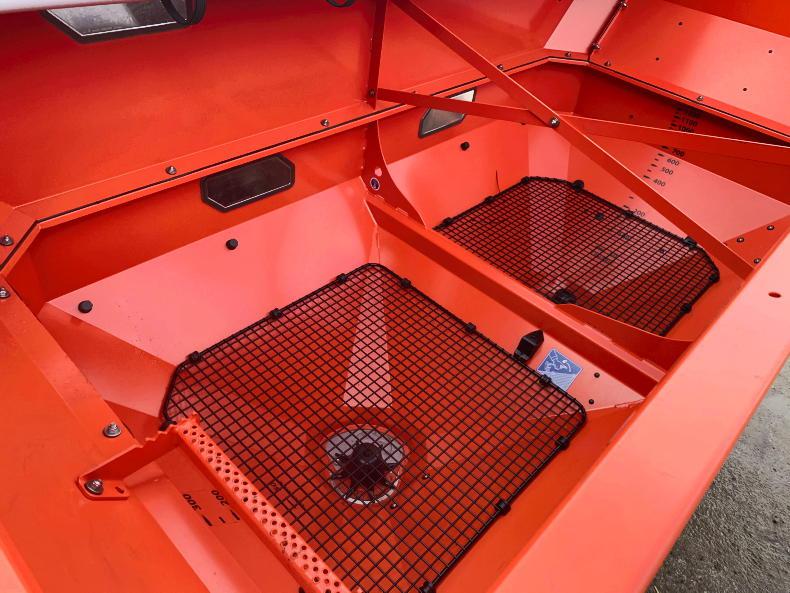
The build quality and paint finish is something the Hickey's can not fault after 21 years with the brand.
Features
Standard features of the Axis-M 30.2 EMC include the brand’s M-Drive maintenance free drive system for both discs and the slow-running agitators. All shafts and angular gearboxes run in an oil or grease bath and are protected from fertiliser dust, dirt, moisture and mechanical damage. There is also an integrated overload protection system to prevent overloading of the driveline due to blockages etc.
The CDA Spreading technology option allows for electronic drop point adjustment and eliminates manual adjustment, meaning setup is more easily done from the cab. This is a convenient feature according to Gerard. Both of Hickeys’ machines are equipped with the hydraulically engaged Telimat T25 border spreading kit which is simple and effective.
Thanks to Rauch’s EMC technology, weigh cells were not required and help keep cost down to some extent, Gerard said. Electronic Massflow Control (EMC) is Rauch’s answer to measuring the flow rate of fertiliser.
The most recent system is based on the principle that the drive torque of each disc is proportional to the flow of fertiliser. In simple terms this means the rate of fertiliser leaving the spreading vanes is measured through the torque in the gearbox. Therefore, weigh cells are not necessarily needed but the option is available (+M).
EMC technology controls flowrate on each side of the machine individually. Gerard noted that while spreading, shutter position on either side constantly changes independently to achieve the set flowrate, all of which is displayed on the terminal in the cab.
The Varispread V8 with the Quantron-A terminal allows for eight section part width section control as standard. Rauch achieve sectional control by means of adjusting fertiliser drop point and flow rate respectively.

The Telimat T25 border spreading kit is simple and effective.
Build quality
The spreader is strongly built and well painted, noted Gerard. However, with the largest 1,800l extension fitted, it is high he said. To make the hopper more accessible, Rauch does offer an optional side ladder but Gerard and the team instead designed and fabricated a stainless-steel rear platform to stand on while loading the spreader which he feels is a better job. The Hickeys have also fabricated storage stands for each spreader so therefore don’t opt for the castor storage wheels.
The only slight downside Gerard noted was the quality of the hopper cover, something he feels is a little flimsy compared to other spreaders on the market. Everything else from how it empties to the ease of wash down is straightforward with minimal nooks and crannies to hold fertiliser residue.
Verdict
Spreading with Rauch machines for 21 years now, the Hickeys have never once looked back. With the front line spreader applying over 800t annually, to say it’s tried and tested is an understatement.
“They’re a very hard machine to fault in any respect,” said Gerard. “Built quality and spread quality are top class. Whether it’s small quantity applications or large, accuracy remains constant. We tend to spread everything around 14-15km/h which is never a problem. Typically a set of vanes will last for about 700t.
“In the earlier years, we would have upgraded machines every four to five years but with the quality of the actuators and components now being used, we can get at least an extra year before seeing similar signs of wear.
“Rauch has a great mobile app for carrying out calibrations which is always bang on the mark, regardless of the product.
“Every two years we overhaul the spreader’s driveline and replace bearings as a preventive measure. The service from Mid-Louth Garage too has been excellent and a large factor as to why we’ve stuck with the brand throughout the past 21 years,”added Gerard.
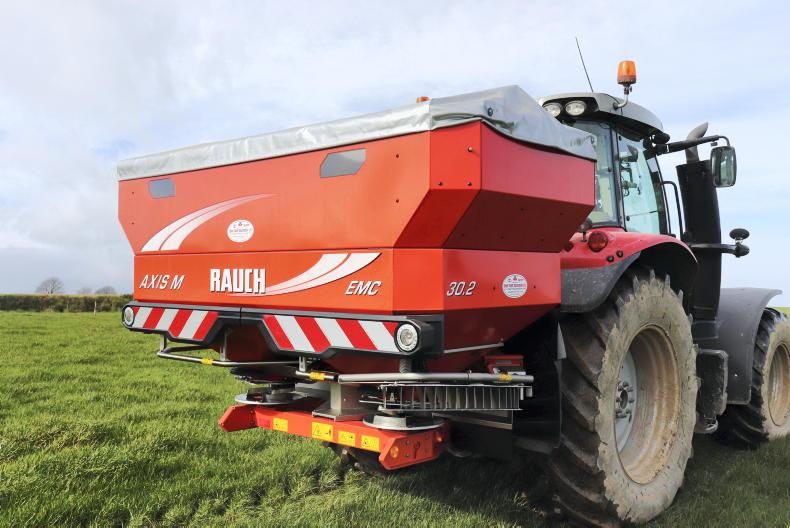
Having demoed larger mounted spreaders, Gerard believes that too large of a tractor is required for comfortable operation.
Likes
Build quality.Ease of calibration.Dislikes
Hopper cover a little flimsy.Spec
Model: Axis-M. Model: Axis-M 30.2 EMC.Hopper capacity: 3,200kg.Spreading width: 12-42mSection control: eight part-width sections (alteration of drop point and shutter position).Technology: Electronic mass flow (EMC) & VariSpread Pro. Discs and vanes: S8 VXR plus (30-42m).List price: €25,000 plus VAT.
Hickey Farms is a large-scale tillage and beef farming enterprise, run by Gerard Hickey alongside his father Martin and uncle Patrick, on the outskirts of Ardee. The farm currently comprises 2,000 acres of cereals, 600 acres of potatoes and 250 acres of vegetables alongside 400 head of beef cattle.
In order to get through the heavy workload, the Hickeys run two Rauch Axis 30.2 EMC mounted fertiliser spreaders. Spreading large quantities of product and covering big acreage annually and after numerous new machines, the family has stuck with the Rauch brand since 2004.
Why mounted?
While the Hickeys could more than justify a large capacity trailed spreader, Gerard and the lads feel that two mounted machines suit their situation best. “With the mounted spreaders we can either run both together or split them up. Two machines work well together when applying straights. For example, one machine could be setup for nitrogen and the other for potash which means we can finish one block and move onto the next without having to continuously make setting changes. In the earlier years too, we found the accuracy of mounted spreaders much better,” outlined Gerard.
Another benefit Gerard pointed out about running mounted machines over trailed was replacement cost and the ability to stagger their replacement.

Working on 30m tramlines, the spreaders are fitted with S8 discs.

The Hickey's fabricate and fit a stainless steel access platform to help when loading the spreader.
Axis-M 30.2 EMC
In recent months, the Hickeys have upgraded their spreaders for two new identical Axis M 30.2 EMC machines, the same as the previous models.
Although Rauch do offer a higher capacity mounted Axis M 50.2 EMC+W model with a 4,200l capacity hopper, Gerard feels that it is too much weight and requires too large of a tractor. The 3,200l hopper of the Axis M 30.2 EMC on the other hand is a better all-rounder.
“There are times a tonne or two less could be the difference in working and not working,” he said.
“We tend to fill on the headland with a telehandler so it’s not a big loss in time if we carry a tonne less and refill more frequently. Anything larger is placing a lot of weight on the tractor’s back axle which in turn means additional ballast and a heavier overall gross weight which isn’t good on the shoulders of the year
when the aim is to minimise soil compaction.”
The Hickeys run 30m tramlines so therefore opt to run S8 (30-42m) discs and vanes. Although S6 (24m-36m) discs are rated for 30m, Gerard pointed out that the spread pattern of the S8 discs is much tighter to the rear of the spreader in comparison to the S6 and is therefore more favourable.
The Hickeys tend to spread with some of the older tractors in the fleet, predominately a Case IH CVX 185 and a CVX 195. Being non-Isobus tractors, the lads opt for the Quantron-A control terminal.
Having adopted Isobus in years gone by, the family later decided to move away in order to keep things simple. “We had communication issues with some earlier Isobus machines which led to the implement manufacturer blaming the tractor manufacturer and vice versa. The easiest solution was to revert to implement specific control terminals, which we did, and it works well.”

Both spreaders are operated via the Quantron- A contrl terminal.

The build quality and paint finish is something the Hickey's can not fault after 21 years with the brand.
Features
Standard features of the Axis-M 30.2 EMC include the brand’s M-Drive maintenance free drive system for both discs and the slow-running agitators. All shafts and angular gearboxes run in an oil or grease bath and are protected from fertiliser dust, dirt, moisture and mechanical damage. There is also an integrated overload protection system to prevent overloading of the driveline due to blockages etc.
The CDA Spreading technology option allows for electronic drop point adjustment and eliminates manual adjustment, meaning setup is more easily done from the cab. This is a convenient feature according to Gerard. Both of Hickeys’ machines are equipped with the hydraulically engaged Telimat T25 border spreading kit which is simple and effective.
Thanks to Rauch’s EMC technology, weigh cells were not required and help keep cost down to some extent, Gerard said. Electronic Massflow Control (EMC) is Rauch’s answer to measuring the flow rate of fertiliser.
The most recent system is based on the principle that the drive torque of each disc is proportional to the flow of fertiliser. In simple terms this means the rate of fertiliser leaving the spreading vanes is measured through the torque in the gearbox. Therefore, weigh cells are not necessarily needed but the option is available (+M).
EMC technology controls flowrate on each side of the machine individually. Gerard noted that while spreading, shutter position on either side constantly changes independently to achieve the set flowrate, all of which is displayed on the terminal in the cab.
The Varispread V8 with the Quantron-A terminal allows for eight section part width section control as standard. Rauch achieve sectional control by means of adjusting fertiliser drop point and flow rate respectively.

The Telimat T25 border spreading kit is simple and effective.
Build quality
The spreader is strongly built and well painted, noted Gerard. However, with the largest 1,800l extension fitted, it is high he said. To make the hopper more accessible, Rauch does offer an optional side ladder but Gerard and the team instead designed and fabricated a stainless-steel rear platform to stand on while loading the spreader which he feels is a better job. The Hickeys have also fabricated storage stands for each spreader so therefore don’t opt for the castor storage wheels.
The only slight downside Gerard noted was the quality of the hopper cover, something he feels is a little flimsy compared to other spreaders on the market. Everything else from how it empties to the ease of wash down is straightforward with minimal nooks and crannies to hold fertiliser residue.
Verdict
Spreading with Rauch machines for 21 years now, the Hickeys have never once looked back. With the front line spreader applying over 800t annually, to say it’s tried and tested is an understatement.
“They’re a very hard machine to fault in any respect,” said Gerard. “Built quality and spread quality are top class. Whether it’s small quantity applications or large, accuracy remains constant. We tend to spread everything around 14-15km/h which is never a problem. Typically a set of vanes will last for about 700t.
“In the earlier years, we would have upgraded machines every four to five years but with the quality of the actuators and components now being used, we can get at least an extra year before seeing similar signs of wear.
“Rauch has a great mobile app for carrying out calibrations which is always bang on the mark, regardless of the product.
“Every two years we overhaul the spreader’s driveline and replace bearings as a preventive measure. The service from Mid-Louth Garage too has been excellent and a large factor as to why we’ve stuck with the brand throughout the past 21 years,”added Gerard.

Having demoed larger mounted spreaders, Gerard believes that too large of a tractor is required for comfortable operation.
Likes
Build quality.Ease of calibration.Dislikes
Hopper cover a little flimsy.Spec
Model: Axis-M. Model: Axis-M 30.2 EMC.Hopper capacity: 3,200kg.Spreading width: 12-42mSection control: eight part-width sections (alteration of drop point and shutter position).Technology: Electronic mass flow (EMC) & VariSpread Pro. Discs and vanes: S8 VXR plus (30-42m).List price: €25,000 plus VAT. 









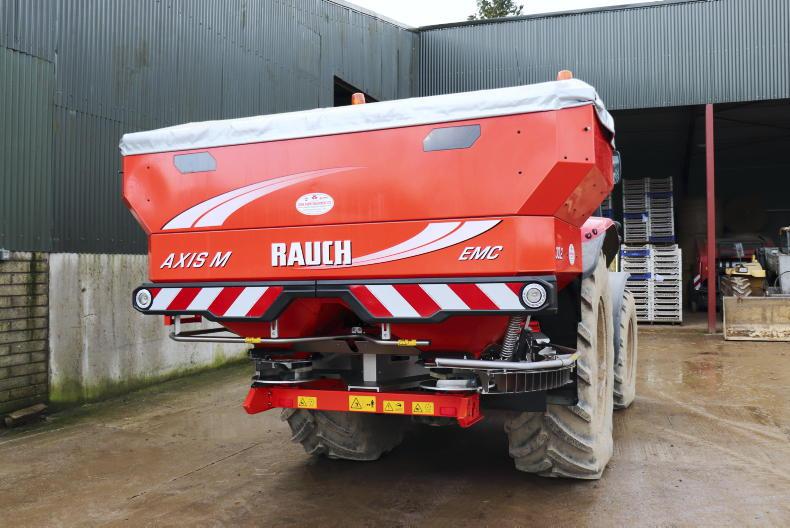


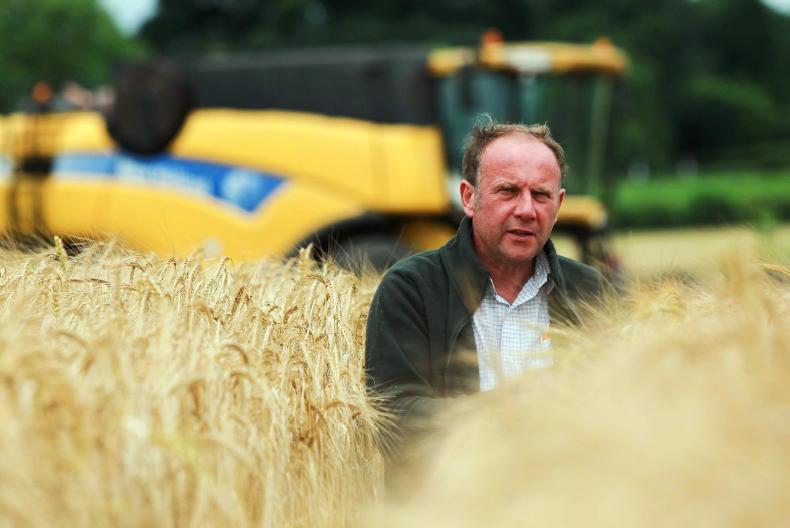
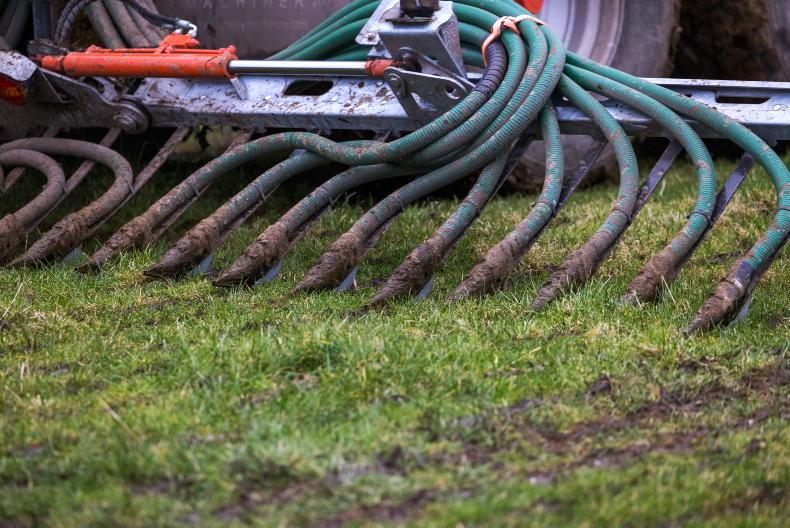
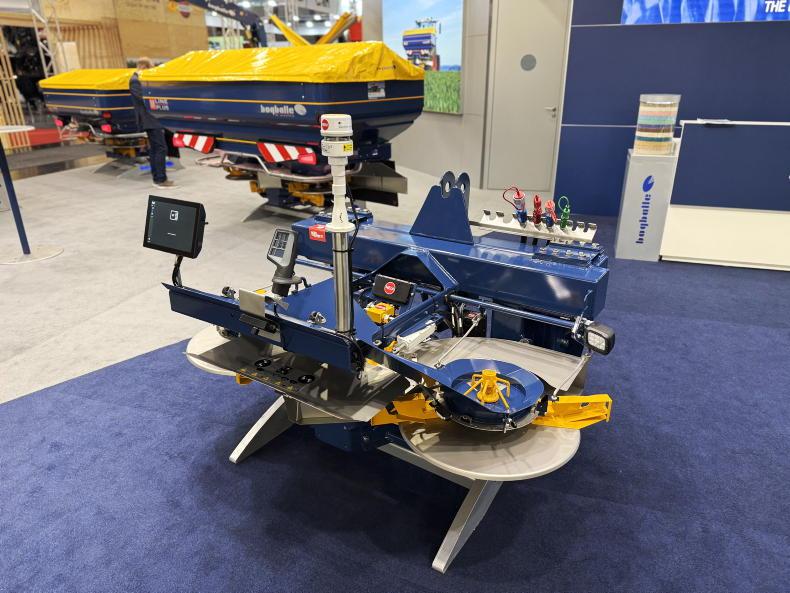
SHARING OPTIONS